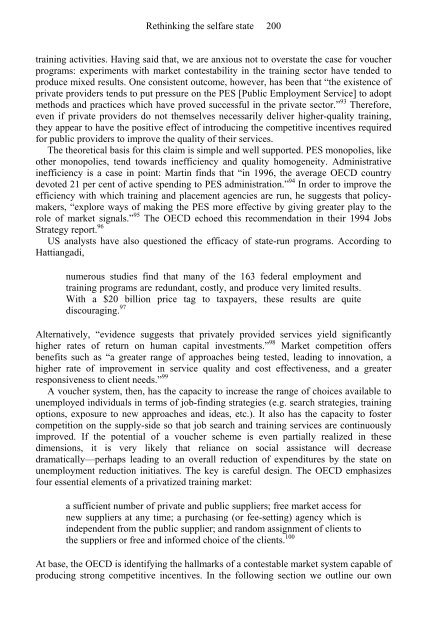Rethinking the Welfare State: The prospects for ... - e-Library
Rethinking the Welfare State: The prospects for ... - e-Library
Rethinking the Welfare State: The prospects for ... - e-Library
Create successful ePaper yourself
Turn your PDF publications into a flip-book with our unique Google optimized e-Paper software.
<strong>Rethinking</strong> <strong>the</strong> selfare state 200<br />
training activities. Having said that, we are anxious not to overstate <strong>the</strong> case <strong>for</strong> voucher<br />
programs: experiments with market contestability in <strong>the</strong> training sector have tended to<br />
produce mixed results. One consistent outcome, however, has been that “<strong>the</strong> existence of<br />
private providers tends to put pressure on <strong>the</strong> PES [Public Employment Service] to adopt<br />
methods and practices which have proved successful in <strong>the</strong> private sector.” 93 <strong>The</strong>re<strong>for</strong>e,<br />
even if private providers do not <strong>the</strong>mselves necessarily deliver higher-quality training,<br />
<strong>the</strong>y appear to have <strong>the</strong> positive effect of introducing <strong>the</strong> competitive incentives required<br />
<strong>for</strong> public providers to improve <strong>the</strong> quality of <strong>the</strong>ir services.<br />
<strong>The</strong> <strong>the</strong>oretical basis <strong>for</strong> this claim is simple and well supported. PES monopolies, like<br />
o<strong>the</strong>r monopolies, tend towards inefficiency and quality homogeneity. Administrative<br />
inefficiency is a case in point: Martin finds that “in 1996, <strong>the</strong> average OECD country<br />
devoted 21 per cent of active spending to PES administration.” 94 In order to improve <strong>the</strong><br />
efficiency with which training and placement agencies are run, he suggests that policymakers,<br />
“explore ways of making <strong>the</strong> PES more effective by giving greater play to <strong>the</strong><br />
role of market signals.” 95 <strong>The</strong> OECD echoed this recommendation in <strong>the</strong>ir 1994 Jobs<br />
Strategy report. 96<br />
US analysts have also questioned <strong>the</strong> efficacy of state-run programs. According to<br />
Hattiangadi,<br />
numerous studies find that many of <strong>the</strong> 163 federal employment and<br />
training programs are redundant, costly, and produce very limited results.<br />
With a $20 billion price tag to taxpayers, <strong>the</strong>se results are quite<br />
discouraging. 97<br />
Alternatively, “evidence suggests that privately provided services yield significantly<br />
higher rates of return on human capital investments.” 98 Market competition offers<br />
benefits such as “a greater range of approaches being tested, leading to innovation, a<br />
higher rate of improvement in service quality and cost effectiveness, and a greater<br />
responsiveness to client needs.” 99<br />
A voucher system, <strong>the</strong>n, has <strong>the</strong> capacity to increase <strong>the</strong> range of choices available to<br />
unemployed individuals in terms of job-finding strategies (e.g. search strategies, training<br />
options, exposure to new approaches and ideas, etc.). It also has <strong>the</strong> capacity to foster<br />
competition on <strong>the</strong> supply-side so that job search and training services are continuously<br />
improved. If <strong>the</strong> potential of a voucher scheme is even partially realized in <strong>the</strong>se<br />
dimensions, it is very likely that reliance on social assistance will decrease<br />
dramatically—perhaps leading to an overall reduction of expenditures by <strong>the</strong> state on<br />
unemployment reduction initiatives. <strong>The</strong> key is careful design. <strong>The</strong> OECD emphasizes<br />
four essential elements of a privatized training market:<br />
a sufficient number of private and public suppliers; free market access <strong>for</strong><br />
new suppliers at any time; a purchasing (or fee-setting) agency which is<br />
independent from <strong>the</strong> public supplier; and random assignment of clients to<br />
<strong>the</strong> suppliers or free and in<strong>for</strong>med choice of <strong>the</strong> clients. 100<br />
At base, <strong>the</strong> OECD is identifying <strong>the</strong> hallmarks of a contestable market system capable of<br />
producing strong competitive incentives. In <strong>the</strong> following section we outline our own


